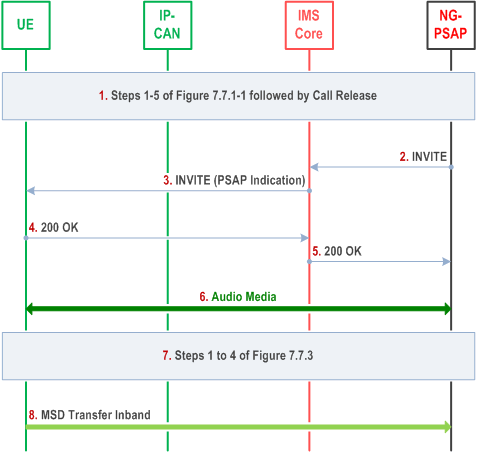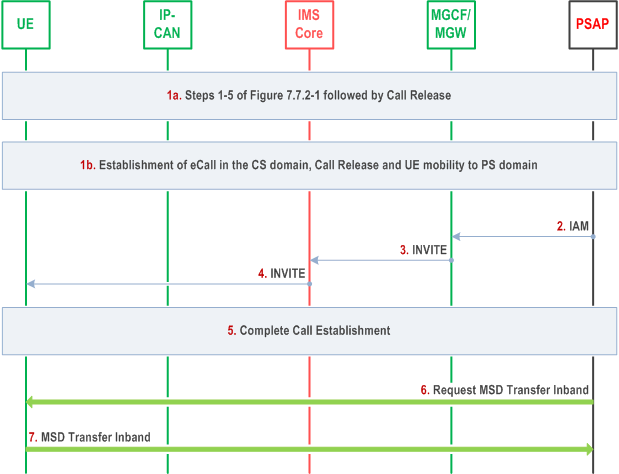Content for TS 23.167 Word version: 19.0.0
7.7.8 Callback from an NG capable PSAP with transfer of updated MSD
7.7.9 Callback from a PSAP in the CS domain with transfer of updated MSD
...
...
7.7.8 Callback from an NG capable PSAP with transfer of updated MSD |R19| p. 36
Figure 7.7.8-1 illustrates a high level call flow for callback to a UE from an NG capable PSAP with transfer of updated MSD after the UE has established an eCall over IMS with the PSAP using the procedure in clause 7.7.1.

Step 1.
The UE and PSAP perform steps 1 to 5 of the procedure shown in Figure 7.7.1-1 after which, at some later point in time, the call is released. Alternatively, the UE and PSAP perform steps 1, 2 and 3a of the procedure shown in Figure 7.7.1-1 with the PSAP returning an indication to the UE that the PSAP cannot accept the call at this time.
Step 2.
The PSAP sends a SIP INVITE to the IMS core in the HPLMN. The SIP INVITE contains a public user identity of the UE as obtained by the PSAP at step 1 and an indication of support by the PSAP for transfer of updated MSD.
Step 3.
The IMS core forwards the SIP INVITE to the UE and includes an indication that the sender is a PSAP.
Step 4.
The UE sends a 200 OK to the IMS Core. If the INVITE includes the PSAP indication and an indication of support for updated MSD at step 3 and if the INVITE at step 3 was received within a configurable time period of either the release or non-acceptance of the eCall over IMS at step 1, then the UE includes an indication of support for transfer of updated MSD.
Step 5.
The IMS core forwards the SIP 200 OK to the PSAP.
Step 6.
The audio channel is established to support bidirectional voice communication.
Step 7.
The PSAP and UE may perform steps 1 to 4 of Figure 7.7.3-1 for transfer of updated MSD. The UE only supports step 7 if the conditions for including an indication of support for transfer of updated MSD at step 4 were met.
Step 8.
If the transfer of updated MSD at step 7 fails, the PSAP may request and the UE may return updated MSD transfer via the eCall Inband Modem, as defined in TS 26.267. The UE conditions for supporting step 8 are the same as the conditions for supporting step 7.
7.7.9 Callback from a PSAP in the CS domain with transfer of updated MSD |R19| p. 37
Figure 7.7.9-1 illustrates a high level call flow for callback to a UE from a PSAP in the CS domain with transfer of updated MSD.
This scenario may occur following eCall session establishment and release with a PSAP not supporting NG-eCall as in clause 7.7.2 or may occur following eCall session establishment and release when the UE is in the CS domain and where the UE later attaches to or registers with a network in the PS domain.

Step 1a.
The UE performs steps 1 to 5 of the procedure shown in Figure 7.7.2-1 followed by a later call release. Alternatively, the UE and PSAP perform steps 1, 2, 3a and 3b of the procedure shown in Figure 7.7.2-1 with the PSAP returning an indication to the UE that the call cannot be accepted.
Step 1b.
As an alternative, the UE, when in the CS domain, establishes or attempts to establish an eCall with a PSAP using procedures in TS 24.008. The eCall is either later released or not accepted by the PSAP and UE mobility occurs to the PS domain.
Step 2.
The PSAP sends or instigates an IAM to an MGCF/MGW in the HPLMN for interfacing to the CS domain. The IAM contains a public telephone identity of the UE as obtained by the PSAP at step 1a or step 1b.
Step 3.
The MGCF sends a SIP INVITE to the IMS core in the HPLMN.
Step 4.
The IMS core forwards the SIP INVITE to the UE and may include an indication that the sender is a PSAP.
Step 5.
Voice call establishment is completed with a voice path only.
Step 6.
The PSAP sends a request for an updated MSD via the eCall Inband Modem, as defined in TS 26.267.
Step 7.
The UE returns updated MSD via the eCall Inband Modem, as defined in TS 26.267 if the following conditions are met:
- The INVITE at step 4 was received within a configurable time period of the release or non-acceptance of the eCall over IMS at step 1; and
- as an implementation option, the INVITE at step 4 includes the PSAP indication.